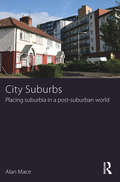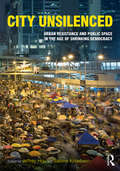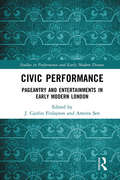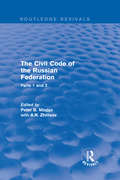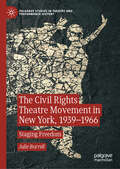- Table View
- List View
City Suburbs: Placing suburbia in a post-suburban world
by Alan MaceThe majority of the world’s population is now urban, and for most this will mean a life lived in the suburbs. City Suburbs considers contemporary Anglo-American suburbia, drawing on research in outer London it looks at life on the edge of a world city from the perspective of residents. Interpreted through Bourdieu’s theory of practice it argues that the contemporary suburban life is one where place and participation are, in combination, strong determinants of the suburban experience. From this perspective suburbia is better seen as a process, an on-going practice of the suburban which is influenced but not determined by the history of suburban development. How residents engage with the city and the legacy of particular places combine powerfully to produce very different experiences across outer London. In some cases suburban residents are able to combine the benefits of the city and their residential location to their advantage but in marginal middle-class areas the relationship with the city is more circumspect as the city represents more threat than opportunity. The importance of this relational experience with the city informs a call to integrate more fully the suburbs into studies of the city.
City Unsilenced: Urban Resistance and Public Space in the Age of Shrinking Democracy
by Jeffrey Hou Sabine KnierbeinWhat do the recent urban resistance tactics around the world have in common? What are the roles of public space in these movements? What are the implications of urban resistance for the remaking of public space in the "age of shrinking democracy"? To what extent do these resistances move from anti- to alter-politics? City Unsilenced brings together a cross-disciplinary group of scholars and scholar-activists to examine the spaces, conditions, and processes in which neoliberal practices have profoundly impacted the everyday social, economic, and political life of citizens and communities around the globe. They explore the commonalities and specificities of urban resistance movements that respond to those impacts. They focus on how such movements make use of and transform the meanings and capacity of public space. They investigate their ramifications in the continued practices of renewing democracies. A broad collection of cases is presented and analyzed, including Movimento Passe Livre (Brazil), Google Bus Blockades San Francisco (USA), the Platform for Mortgage Affected People (PAH) (Spain), the Piqueteros Movement (Argentina), Umbrella Movement (Hong Kong), post-Occupy Gezi Park (Turkey), Sunflower Movement (Taiwan), Occupy Oakland (USA), Syntagma Square (Greece), Researchers for Fair Policing (New York), Urban Movement Congress (Poland), urban activism (Berlin), 1DMX (Mexico), Miyashita Park Tokyo (Japan), 15M Movement (Spain), and Train of Hope and protests against Academic Ball in Vienna (Austria). By better understanding the processes and implications of the recent urban resistances, City Unsilenced contributes to the ongoing debates concerning the role and significance of public space in the practice of lived democracy.
City Unsilenced: Urban Resistance and Public Space in the Age of Shrinking Democracy
by Jeffrey Hou Sabine KnierbeinWhat do the recent urban resistance tactics around the world have in common? What are the roles of public space in these movements? What are the implications of urban resistance for the remaking of public space in the "age of shrinking democracy"? To what extent do these resistances move from anti- to alter-politics? City Unsilenced brings together a cross-disciplinary group of scholars and scholar-activists to examine the spaces, conditions, and processes in which neoliberal practices have profoundly impacted the everyday social, economic, and political life of citizens and communities around the globe. They explore the commonalities and specificities of urban resistance movements that respond to those impacts. They focus on how such movements make use of and transform the meanings and capacity of public space. They investigate their ramifications in the continued practices of renewing democracies. A broad collection of cases is presented and analyzed, including Movimento Passe Livre (Brazil), Google Bus Blockades San Francisco (USA), the Platform for Mortgage Affected People (PAH) (Spain), the Piqueteros Movement (Argentina), Umbrella Movement (Hong Kong), post-Occupy Gezi Park (Turkey), Sunflower Movement (Taiwan), Occupy Oakland (USA), Syntagma Square (Greece), Researchers for Fair Policing (New York), Urban Movement Congress (Poland), urban activism (Berlin), 1DMX (Mexico), Miyashita Park Tokyo (Japan), 15M Movement (Spain), and Train of Hope and protests against Academic Ball in Vienna (Austria). By better understanding the processes and implications of the recent urban resistances, City Unsilenced contributes to the ongoing debates concerning the role and significance of public space in the practice of lived democracy.
Cityscape in the Era of Information and Communication Technologies (The Urban Book Series)
by Agata BonenbergThis book discusses the impact of information and communication technologies, particularly social media, on the structure and landscape of contemporary cities. It presents a multidisciplinary range of theories and practical case studies and addresses a broad readership, from graduate students to practitioners active in the fields of urbanism and the architectural design of urban space. The book includes a wealth of illustrations depicting contemporary architecture and exemplary modern public spaces, as well as diagrams and tables that optimally visualize the concepts and ideas discussed.
Cityscapes in History: Creating the Urban Experience
by Heléna TóthCityscapes in History: Creating the Urban Experience explores the ways in which scholars from a variety of disciplines - history, history of art, geography and architecture - think about and study the urban environment. The concept ’cityscapes’ refers to three different dynamics that shape the development of the urban environment: the interplay between conscious planning and organic development, the tension between social control and its unintended consequences and the relationship between projection and self-presentation, as articulated through civic ceremony and ritual. The book is structured around three sections, each covering a particular aspect of the urban experience. ’The City Planned’ looks at issues related to agency, self-perception, the transfer of knowledge and the construction of space. ’The City Lived’ explores the experience of urbanity and the construction of space as a means of social control. And finally, ’The City as a Stage’ examines the ways in which cultural practices and power-relations shape - and are in turn shaped by - the construction of space. Each section combines the work of scholars from different fields who examine these dynamics through both theoretical essays and empirical research, and provides a coherent framework in which to assess a wide range of chronological and geographical subjects. Taken together the essays in this volume provide a truly interdisciplinary investigation of the urban phenomenon. By making fascinating connections between such seemingly diverse topics as 15th century France and modern America, the collection raises valuable questions about scholarly approaches to urban studies.
Cityscapes in History: Creating the Urban Experience
by Heléna TóthCityscapes in History: Creating the Urban Experience explores the ways in which scholars from a variety of disciplines - history, history of art, geography and architecture - think about and study the urban environment. The concept ’cityscapes’ refers to three different dynamics that shape the development of the urban environment: the interplay between conscious planning and organic development, the tension between social control and its unintended consequences and the relationship between projection and self-presentation, as articulated through civic ceremony and ritual. The book is structured around three sections, each covering a particular aspect of the urban experience. ’The City Planned’ looks at issues related to agency, self-perception, the transfer of knowledge and the construction of space. ’The City Lived’ explores the experience of urbanity and the construction of space as a means of social control. And finally, ’The City as a Stage’ examines the ways in which cultural practices and power-relations shape - and are in turn shaped by - the construction of space. Each section combines the work of scholars from different fields who examine these dynamics through both theoretical essays and empirical research, and provides a coherent framework in which to assess a wide range of chronological and geographical subjects. Taken together the essays in this volume provide a truly interdisciplinary investigation of the urban phenomenon. By making fascinating connections between such seemingly diverse topics as 15th century France and modern America, the collection raises valuable questions about scholarly approaches to urban studies.
Civic Aesthetics: Militarism, Israeli Art and Visual Culture (Radical Aesthetics-Radical Art)
by Noa RoeiAwarded an Honourable Mention by the Association for Israeli Studies. Exploring the politics of the image in the context of Israeli militarized visual culture, Civic Aesthetics examines both the omnipresence of militarism in Israeli culture and society and the way in which this omnipresence is articulated, enhanced, and contested within local contemporary visual art. Looking at a range of contemporary artworks through the lens of “civilian militarism”, Roei employs the theory of various fields, including memory studies, gender studies, landscape theory, and aesthetics, to explore the potential of visual art to communicate military excesses to its viewers. This study builds on the specific sociological concerns of the chosen cases to discuss the complexities of visuality, the visible and non-visible, arguing for art's capacity to expose the scopic regimes that construct their visibility. Images and artworks are often read either out of context, on purely aesthetic or art-historical ground, or as cultural artefacts whose aesthetics play a minor role in their significance. This book breaks with both traditions as it approaches all art, both high and popular art, as part of the surrounding visual culture in which it is created and presented. This approach allows a new theory of the image to come forth, where the relation between the political and the aesthetic is one of exchange, rather than exclusion.
Civic Aesthetics: Militarism, Israeli Art and Visual Culture (Radical Aesthetics-Radical Art)
by Noa RoeiAwarded an Honourable Mention by the Association for Israeli Studies. Exploring the politics of the image in the context of Israeli militarized visual culture, Civic Aesthetics examines both the omnipresence of militarism in Israeli culture and society and the way in which this omnipresence is articulated, enhanced, and contested within local contemporary visual art. Looking at a range of contemporary artworks through the lens of “civilian militarism”, Roei employs the theory of various fields, including memory studies, gender studies, landscape theory, and aesthetics, to explore the potential of visual art to communicate military excesses to its viewers. This study builds on the specific sociological concerns of the chosen cases to discuss the complexities of visuality, the visible and non-visible, arguing for art's capacity to expose the scopic regimes that construct their visibility. Images and artworks are often read either out of context, on purely aesthetic or art-historical ground, or as cultural artefacts whose aesthetics play a minor role in their significance. This book breaks with both traditions as it approaches all art, both high and popular art, as part of the surrounding visual culture in which it is created and presented. This approach allows a new theory of the image to come forth, where the relation between the political and the aesthetic is one of exchange, rather than exclusion.
Civic Performance: Pageantry and Entertainments in Early Modern London (Studies in Performance and Early Modern Drama)
by J. Caitlin Finlayson Amrita SenCivic Performance: Pageantry and Entertainments in Early Modern London brings together a group of essays from across multiple fields of study that examine the socio-cultural, political, economic, and aesthetic dimensions of pageantry in sixteenth and seventeenth-century London. This collection engages with modern interest in the spectacle and historical performances of pageantry and entertainments, including royal entries, progresses, coronation ceremonies, Lord Mayor’s Shows, and processions. Through a discussion of the extant texts, visual records, archival material, and emerging projects in the digital humanities, the chapters elucidate the forms in which the period itself recorded its public rituals, pageantry, and ephemeral entertainments. The diversity of approaches contained in these chapters reflects the collaborative nature of pageantry and civic entertainments, as well as the broad socio-cultural resonances of this form of drama, and in doing so offers a study that is multi-faceted and wide-ranging, much like civic performance itself. Ideal for scholars of Early Modern global politics, economics, and culture; literary and performance studies; print culture; and the digital humanities, Civic Performance casts a new lens on street pageantry and entertainments in the historically and culturally significant locus of Early Modern London.
Civic Performance: Pageantry and Entertainments in Early Modern London (Studies in Performance and Early Modern Drama)
by J. Caitlin Finlayson Amrita SenCivic Performance: Pageantry and Entertainments in Early Modern London brings together a group of essays from across multiple fields of study that examine the socio-cultural, political, economic, and aesthetic dimensions of pageantry in sixteenth and seventeenth-century London. This collection engages with modern interest in the spectacle and historical performances of pageantry and entertainments, including royal entries, progresses, coronation ceremonies, Lord Mayor’s Shows, and processions. Through a discussion of the extant texts, visual records, archival material, and emerging projects in the digital humanities, the chapters elucidate the forms in which the period itself recorded its public rituals, pageantry, and ephemeral entertainments. The diversity of approaches contained in these chapters reflects the collaborative nature of pageantry and civic entertainments, as well as the broad socio-cultural resonances of this form of drama, and in doing so offers a study that is multi-faceted and wide-ranging, much like civic performance itself. Ideal for scholars of Early Modern global politics, economics, and culture; literary and performance studies; print culture; and the digital humanities, Civic Performance casts a new lens on street pageantry and entertainments in the historically and culturally significant locus of Early Modern London.
Civic Revolutionaries: Igniting the Passion for Change in America's Communities
by Douglas Henton John G. Melville Kimberly WaleshCivic Revolutionaries offers a practical guide for renewing the great American tradition of spirited, breakthrough community leadership. By their very nature, revolutionary leaders help their communities reconcile the competing values on which our nation was built: individualism and community, freedom and responsibility, trust and accountability, economy and society. Like the Founders, today's civic revolutionaries are extraordinary leaders who are deeply committed to place, not just to specific issues or constituencies. They provide the vital spark, inspiring others who must ultimately own the revolution if it is to be successful. Written for leaders in business, government, education, and community, Civic Revolutionaries features practical guidance and in-depth case studies from communities across the country. The book provides tested advice to both new and seasoned leaders and draws essential lessons from the American revolutionary tradition to demonstrate how to become an effective leader within the community. Read a Charity Channel review: http://charitychannel.com/publish/templates/?a=294&z=25
Civic Spaces and Desire
by Charles Drozynski Diana BeljaarsCivic Spaces and Desire presents an original and critical appraisal of civic spaces for a novel theoretical intersection of architecture and human geography. The authors address civic spaces that embody a strong moral code, such as a remembrance park or a casino, in various places in the United Kingdom, Europe, North America, Australia and Asia. The consecutive chapters of the book present these chosen spaces as the interconnection between the everyday and the ideological. By doing so the book reimagines the socio-political effects of the countercultural assemblages and ontologies of difference that these spaces produce, represent and foster, as presented through outcasts and nomads of various kinds and forms. The book reflects on different interpretations of the key texts from primarily post-linguistic theoreticians, such as Gilles Deleuze, Félix Guattari and Jacques Derrida. It will benefit students and academics in architecture, geography, philosophy and urban studies and planning, who seek to understand the politics of space, place and civility. By deconstructing normative ideological constructs, the book uses the concept of desire to explore the tensions between expectations of civic spaces and the disappointment and wonder of their immanent existence. Chapter 1 of this book is freely available as a downloadable Open Access PDF at http://www.taylorfrancis.com under a Creative Commons Attribution-Non Commercial-No Derivatives (CC-BY-NC-ND) 4.0 license.
Civic Spaces and Desire
by Charles Drozynski Diana BeljaarsCivic Spaces and Desire presents an original and critical appraisal of civic spaces for a novel theoretical intersection of architecture and human geography. The authors address civic spaces that embody a strong moral code, such as a remembrance park or a casino, in various places in the United Kingdom, Europe, North America, Australia and Asia. The consecutive chapters of the book present these chosen spaces as the interconnection between the everyday and the ideological. By doing so the book reimagines the socio-political effects of the countercultural assemblages and ontologies of difference that these spaces produce, represent and foster, as presented through outcasts and nomads of various kinds and forms. The book reflects on different interpretations of the key texts from primarily post-linguistic theoreticians, such as Gilles Deleuze, Félix Guattari and Jacques Derrida. It will benefit students and academics in architecture, geography, philosophy and urban studies and planning, who seek to understand the politics of space, place and civility. By deconstructing normative ideological constructs, the book uses the concept of desire to explore the tensions between expectations of civic spaces and the disappointment and wonder of their immanent existence. Chapter 1 of this book is freely available as a downloadable Open Access PDF at http://www.taylorfrancis.com under a Creative Commons Attribution-Non Commercial-No Derivatives (CC-BY-NC-ND) 4.0 license.
The Civil Code of the Russian Federation: Parts 1 and 2 (Routledge Revivals)
by Peter B MaggsThis title was first published in 1997: This is the definitive English translation of the new Russian Civil Code (Parts 1 and 2), often referred to as "the second Russian Constitution". The Civil Code of the Russian Federation is the result of a collaborative effort of a leading United States expert on Russian law and of the staff of the Private Law Research Center attached to the Office of the President of the Russian Federation -- the Center that had primary responsibility for drafting the new Civil Code. The authoritative introduction, complete table of contents. and comprehensive index combine to set this work far beyond the utility of any existing translations of the Civil Code. It will be a must-have resource for government, law and international business collections.
The Civil Code of the Russian Federation: Parts 1 and 2 (Routledge Revivals)
by Peter B MaggsThis title was first published in 1997: This is the definitive English translation of the new Russian Civil Code (Parts 1 and 2), often referred to as "the second Russian Constitution". The Civil Code of the Russian Federation is the result of a collaborative effort of a leading United States expert on Russian law and of the staff of the Private Law Research Center attached to the Office of the President of the Russian Federation -- the Center that had primary responsibility for drafting the new Civil Code. The authoritative introduction, complete table of contents. and comprehensive index combine to set this work far beyond the utility of any existing translations of the Civil Code. It will be a must-have resource for government, law and international business collections.
The Civil Contract of Photography
by Ariella AzoulayIn this groundbreaking work, Ariella Azoulay thoroughly revises our understanding of the ethical status of photography. It must, she insists, be understood in its inseparability from the many catastrophes of recent history. She argues that photography is a particular set of relations between individuals and the powers that govern them and, at the same time, a form of relations among equals that constrains that power. Anyone, even a stateless person, who addresses others through photographs or occupies the position of a photograph’s addressee, is or can become a member of the citizenry of photography.The crucial arguments of the book concern two groups that have been rendered invisible by their state of exception: the Palestinian noncitizens of Israel and women in Western societies. Azoulay’s leading question is: Under what legal, political, or cultural conditions does it become possible to see and show disaster that befalls those with flawed citizenship in a state of exception? The Civil Contract of Photography is an essential work for anyone seeking to understand the disasters of recent history and the consequences of how they and their victims are represented.
The Civil Rights Theatre Movement in New York, 1939–1966: Staging Freedom (Palgrave Studies in Theatre and Performance History)
by Julie BurrellThis book argues that African American theatre in the twentieth century represented a cultural front of the civil rights movement. Highlighting the frequently ignored decades of the 1940s and 1950s, Burrell documents a radical cohort of theatre artists who became critical players in the fight for civil rights both onstage and offstage, between the Popular Front and the Black Arts Movement periods. The Civil Rights Theatre Movement recovers knowledge of little-known groups like the Negro Playwrights Company and reconsiders Broadway hits including Lorraine Hansberry’s A Raisin in the Sun, showing how theatre artists staged radically innovative performances that protested Jim Crow and U.S. imperialism amidst a repressive Cold War atmosphere. By conceiving of class and gender as intertwining aspects of racism, this book reveals how civil rights theatre artists challenged audiences to reimagine the fundamental character of American democracy.
Civilisation: A Personal View
by Kenneth ClarkKenneth Clark's sweeping narrative looks at how Western Europe evolved in the wake of the collapse of the Roman Empire, to produce the ideas, books, buildings, works of art and great individuals that make up our civilisation.The author takes us from Iona in the ninth century to France in the twelfth, from Florence to Urbino, from Germany to Rome, England, Holland and America. Against these historical backgrounds he sketches an extraordinary cast of characters -- the men and women who gave new energy to civilisation and expanded our understanding of the world and of ourselves. He also highlights the works of genius they produced -- in architecture, sculpture and painting, in philosophy, poetry and music, and in science and engineering, from Raphael's School of Athens to the bridges of Brunel.
Civilising Caliban: The Misuse of Art 1875–1980
by Frances Borzello'I wrote my thesis because it seemed incredible that a nineteenth century cleric could believe that paintings had the power to civilise his community of London's poorest. Yet that is what he did believe and his ideas were exported round the world. I still don't know whether he was right...' Frances BorzelloWhat is the purpose of art? Aside from aesthetic considerations, does it have socio-political functions? Art critic Frances Borzello reflected on this in her doctoral thesis, later expanded for publication in 1987 as Civilising Caliban. Therein she traced a link between Victorian-era exhibitions mounted for Whitechapel's poor by Anglican vicar Samuel Barnett to the munificent post-war patronage of the Arts Council. In a new preface to this edition Borzello reflects on how the idea of 'art for all' has fared - along with the questions of who pays for it and what good it achieves.
Civilizing Rituals: Inside Public Art Museums (Re Visions Ser.)
by Carol DuncanIllustrated with over fifty photos, Civilizing Rituals merges contemporary debates with lively discussion and explores central issues involved in the making and displaying of art as industry and how it is presented to the community. Carol Duncan looks at how nations, institutions and private individuals present art , and how art museums are shaped by cultural, social and political determinants. Civilizing Rituals is ideal reading for students of art history and museum studies, and professionals in the field will also find much of interest here.
Civilizing Rituals: Inside Public Art Museums
by Carol DuncanIllustrated with over fifty photos, Civilizing Rituals merges contemporary debates with lively discussion and explores central issues involved in the making and displaying of art as industry and how it is presented to the community. Carol Duncan looks at how nations, institutions and private individuals present art , and how art museums are shaped by cultural, social and political determinants. Civilizing Rituals is ideal reading for students of art history and museum studies, and professionals in the field will also find much of interest here.
Civilizing the Museum: The Collected Writings of Elaine Heumann Gurian
by Elaine Heumann GurianWritten over a thirty-five year career, the essays in Civilizing the Museum introduce students to the powerful, sometimes contested, and often unrealized notion that museums should welcome all because they house the collective memory of all. Drawing on her experience working in and with museums in the US and throughout the world, Author Elaine Heumann Gurian explores the possibilities for making museums more central and relevant to society. The twenty-two essays are organized around five main themes: * museum definitions* civic responsibility and social service* architectural spaces* exhibitions* spirituality and rationality. And these themes address the elements that would make museums more inclusive such as: * exhibition technique* space configurations* the personality of the director* the role of social service* power sharing* types of museums* the need for emotion humour and spirituality. Without abandoning the traditional museum processes, Gurian shows how museums can honour tradition whilst embracing the new. Enriched by her experience in groundbreaking museums, Gurian has provided a book that provokes thought, dialogue and action for students and professionals in the field to realize the inclusive potential of museums.
Civilizing the Museum: The Collected Writings of Elaine Heumann Gurian
by Elaine Heumann GurianWritten over a thirty-five year career, the essays in Civilizing the Museum introduce students to the powerful, sometimes contested, and often unrealized notion that museums should welcome all because they house the collective memory of all. Drawing on her experience working in and with museums in the US and throughout the world, Author Elaine Heumann Gurian explores the possibilities for making museums more central and relevant to society. The twenty-two essays are organized around five main themes: * museum definitions* civic responsibility and social service* architectural spaces* exhibitions* spirituality and rationality. And these themes address the elements that would make museums more inclusive such as: * exhibition technique* space configurations* the personality of the director* the role of social service* power sharing* types of museums* the need for emotion humour and spirituality. Without abandoning the traditional museum processes, Gurian shows how museums can honour tradition whilst embracing the new. Enriched by her experience in groundbreaking museums, Gurian has provided a book that provokes thought, dialogue and action for students and professionals in the field to realize the inclusive potential of museums.
Cladding of Buildings
by Alan J. Brookes Maarten MeijsThis key text addresses the topic of lightweight claddings in buildings and is a useful guide and reference resource. Written by well-known specialists in the field, this fourth edition of an established text has been revised throughout to incorporate the latest environmental issues, the use of wood and terracotta in cladding, and use of new materials, particularly the new moulded materials. Two new chapters cover wood and terracotta in cladding. The main types of cladding systems are described in detail and methods of production, performance characteristics, applications and methods of assembly are explained clearly. Illustrated throughout with photographs and numerous line drawings, this is an essential overview of the subject for both the student and the practising architect.
Cladding of Buildings
by Alan J. Brookes Maarten MeijsThis key text addresses the topic of lightweight claddings in buildings and is a useful guide and reference resource. Written by well-known specialists in the field, this fourth edition of an established text has been revised throughout to incorporate the latest environmental issues, the use of wood and terracotta in cladding, and use of new materials, particularly the new moulded materials. Two new chapters cover wood and terracotta in cladding. The main types of cladding systems are described in detail and methods of production, performance characteristics, applications and methods of assembly are explained clearly. Illustrated throughout with photographs and numerous line drawings, this is an essential overview of the subject for both the student and the practising architect.
